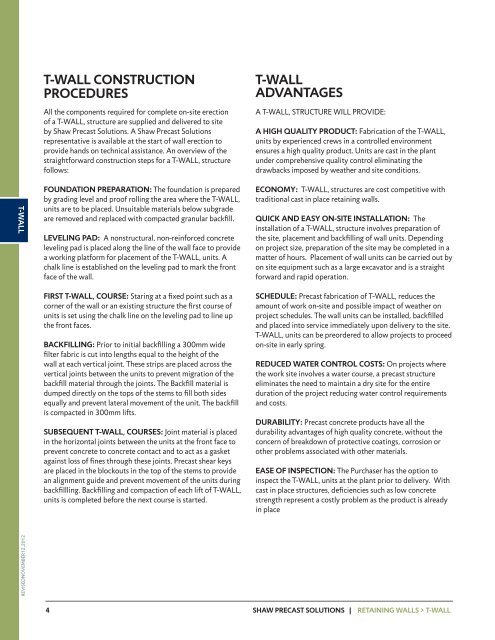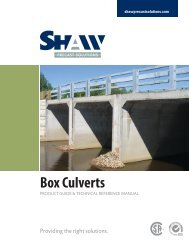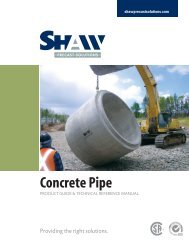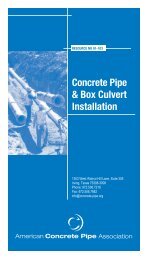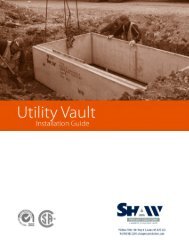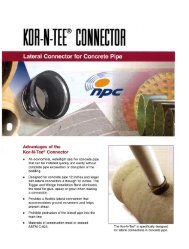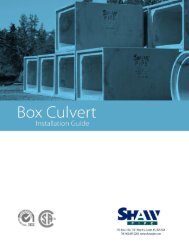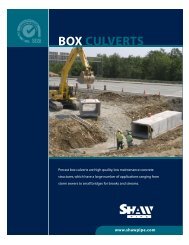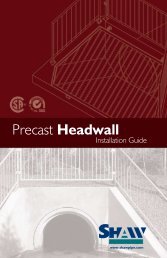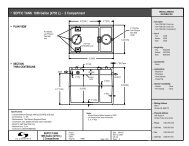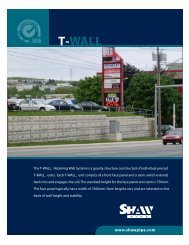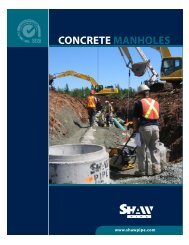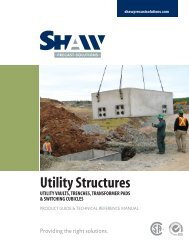Retaining Walls Product Guide - Shaw Precast Solutions
Retaining Walls Product Guide - Shaw Precast Solutions
Retaining Walls Product Guide - Shaw Precast Solutions
You also want an ePaper? Increase the reach of your titles
YUMPU automatically turns print PDFs into web optimized ePapers that Google loves.
T-WALL CONSTRUCTIONPROCEDURESAll the components required for complete on-site erectionof a T-WALL‚ structure are supplied and delivered to siteby <strong>Shaw</strong> <strong>Precast</strong> <strong>Solutions</strong>. A <strong>Shaw</strong> <strong>Precast</strong> <strong>Solutions</strong>representative is available at the start of wall erection toprovide hands on technical assistance. An overview of thestraightforward construction steps for a T-WALL‚ structurefollows:T-WALLADVANTAGESA T-WALL‚ STRUCTURE WILL PROVIDE:A HIGH QUALITY PRODUCT: Fabrication of the T-WALL‚units by experienced crews in a controlled environmentensures a high quality product. Units are cast in the plantunder comprehensive quality control eliminating thedrawbacks imposed by weather and site conditions.T-WALLFOUNDATION PREPARATION: The foundation is preparedby grading level and proof rolling the area where the T-WALL‚units are to be placed. Unsuitable materials below subgradeare removed and replaced with compacted granular backfill.LEVELING PAD: A nonstructural, non-reinforced concreteleveling pad is placed along the line of the wall face to providea working platform for placement of the T-WALL‚ units. Achalk line is established on the leveling pad to mark the frontface of the wall.ECONOMY: T-WALL‚ structures are cost competitive withtraditional cast in place retaining walls.QUICK AND EASY ON-SITE INSTALLATION: Theinstallation of a T-WALL‚ structure involves preparation ofthe site, placement and backfilling of wall units. Dependingon project size, preparation of the site may be completed in amatter of hours. Placement of wall units can be carried out byon site equipment such as a large excavator and is a straightforward and rapid operation.FIRST T-WALL‚ COURSE: Staring at a fixed point such as acorner of the wall or an existing structure the first course ofunits is set using the chalk line on the leveling pad to line upthe front faces.BACKFILLING: Prior to initial backfilling a 300mm widefilter fabric is cut into lengths equal to the height of thewall at each vertical joint. These strips are placed across thevertical joints between the units to prevent migration of thebackfill material through the joints. The Backfill material isdumped directly on the tops of the stems to fill both sidesequally and prevent lateral movement of the unit. The backfillis compacted in 300mm lifts.SUBSEQUENT T-WALL‚ COURSES: Joint material is placedin the horizontal joints between the units at the front face toprevent concrete to concrete contact and to act as a gasketagainst loss of fines through these joints. <strong>Precast</strong> shear keysare placed in the blockouts in the top of the stems to providean alignment guide and prevent movement of the units duringbackfillling. Backfilling and compaction of each lift of T-WALL‚units is completed before the next course is started.SCHEDULE: <strong>Precast</strong> fabrication of T-WALL‚ reduces theamount of work on-site and possible impact of weather onproject schedules. The wall units can be installed, backfilledand placed into service immediately upon delivery to the site.T-WALL‚ units can be preordered to allow projects to proceedon-site in early spring.REDUCED WATER CONTROL COSTS: On projects wherethe work site involves a water course, a precast structureeliminates the need to maintain a dry site for the entireduration of the project reducing water control requirementsand costs.DURABILITY: <strong>Precast</strong> concrete products have all thedurability advantages of high quality concrete, without theconcern of breakdown of protective coatings, corrosion orother problems associated with other materials.EASE OF INSPECTION: The Purchaser has the option toinspect the T-WALL‚ units at the plant prior to delivery. Withcast in place structures, deficiencies such as low concretestrength represent a costly problem as the product is alreadyin placeREVISED November 12, 20124 SHAW PRECAST SOLUTIONS | RETAINING WALLS > T-WALL


